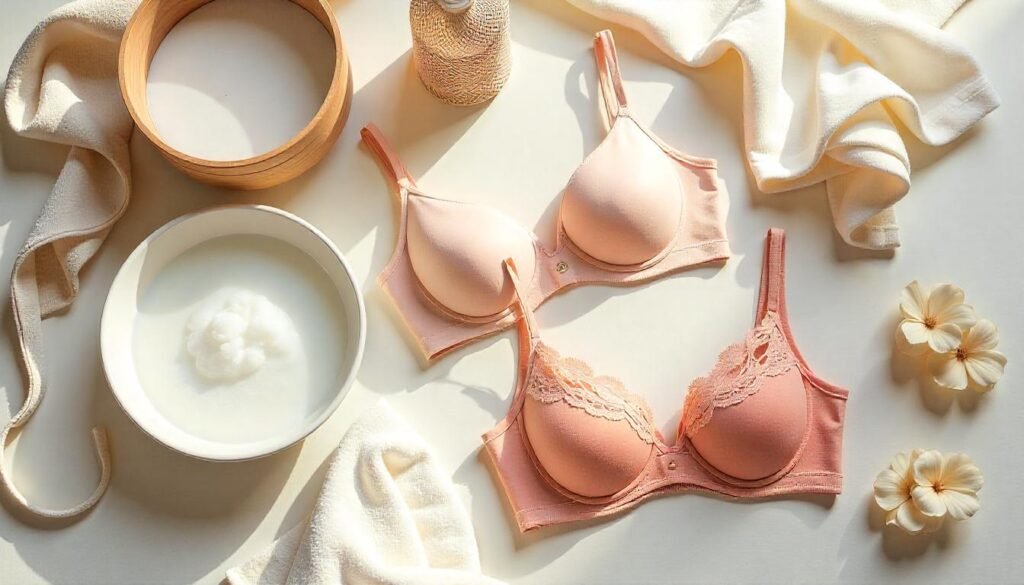Washing your bra wrong is ruining it faster than you think. From misshapen cups to stretched-out straps, one careless spin cycle can undo all the comfort and support you paid for.
But this isn’t just about keeping your lingerie drawer pretty — it’s about preserving the structure, elasticity, and performance of one of the most underappreciated essentials in your wardrobe. Bras are delicate, engineered garments, and how you care for them determines how long they serve you.
In this guide, you’ll learn exactly when to wash your bras, how to do it right (whether by hand or machine), how to dry and store them to preserve their shape, and the pro tips that can add months — even years — to your favorite bra’s lifespan. Let’s lift the mystery and support your support system.
How Often Should You Wash Your Bra?
The golden rule? Wash your everyday bras every 3 to 5 wears — that is, if you’re not breaking a serious sweat. This keeps oils, skin cells, and odors from building up without stressing the fabric unnecessarily.
But there are key exceptions:
- Sports bras should be washed after every use — sweat, bacteria, and body oils build up fast during workouts.
- Hot climates or high-sweat days call for more frequent washing.
- Skin conditions or post-surgery garments may require daily cleaning to prevent irritation or infection.
Overwashing can break down the elastic, wear out the fabric, and fade the color — shortening your bra’s life.
Underwashing, on the other hand, traps bacteria, degrades the fibers with built-up oils, and can even cause skin irritation.
Finding that sweet spot between too often and not enough is key to keeping your bras clean, comfortable, and in shape.
The Right Way: Hand Washing Bras
Why It’s the Gold Standard
Hand washing is hands-down (pun intended) the gentlest, most effective way to clean bras. Unlike the brute force of a washing machine, it preserves delicate lace, molded cups, underwire integrity, and — most importantly — the elastic that gives your bra life and lift.
If you’ve ever pulled a frayed or misshapen bra from a washer drum, you already know why the slow, tender method wins.
Step-by-Step: How to Hand Wash a Bra Like a Pro
- Fill a basin or clean sink with cool or lukewarm water — not hot.
- Add a small amount of mild detergent — ideally one made for delicates or baby clothes. Stir gently to mix.
- Submerge your bras and let them soak for 15 to 30 minutes. This loosens body oils and residue.
- Gently rub high-contact areas (like the band and underarm sections) with your fingers — no scrubbing!
- Rinse thoroughly with cool, clean water until there’s no suds or detergent left.
- Press out water with a towel — lay the bra flat on a clean towel, fold it over, and press. Never twist or wring.
- Reshape the cups while still damp to help them dry in their original form.
- Lay flat to dry on a towel, or hang by the center gore (the piece between the cups), not the straps.
Key Don’ts: Avoid These Common Mistakes
- ❌ No hot water — it breaks down elastics and causes shrinkage.
- ❌ Don’t twist or wring out your bras — this can crush padding and warp wires.
- ❌ Skip harsh soaps or fabric softeners — they degrade delicate fibers.
- ❌ Never hang from the straps — gravity can stretch them out before the bra is even dry.
Machine Washing: How to Do It Without Damage
When Machine Washing Is Okay
Let’s be real — not everyone has time to hand wash every bra. And that’s okay. Machine washing can be safe for bras if done carefully and occasionally. It’s best for sturdier styles without lace or delicate trim, like T-shirt bras or everyday cotton blends. But even then, treat it like a gentle negotiation — not a power wash.
Protective Steps to Prevent Damage
- Fasten all hooks and clasps to prevent snagging on other garments.
- Place each bra in a mesh lingerie bag to protect it from tumbling, tangling, and stretching.
- Use a delicate or gentle cycle with cold water. Heat damages elastic; cold keeps things cool — literally and figuratively.
- Add a mild detergent specifically designed for delicates or lingerie.
- Wash with other soft items, like underwear or T-shirts. Avoid mixing with jeans or heavy towels.
What to Avoid
- ❌ Fabric softeners — they coat elastic fibers and make them break down faster.
- ❌ Rough or high-speed spin cycles — too aggressive and likely to warp underwires or misshape cups.
- ❌ Overloading the machine — bras need space to move gently, not get crushed in a laundry mosh pit.
- ❌ Mixing with hooks or zippers — anything that can snag or scratch is a no-go.
Machine washing isn’t ideal, but with the right prep, it can be a convenient compromise that keeps your bras in the rotation — and out of the damage zone.
Drying Bras: The Make-or-Break Moment
Why Dryers Destroy Bras
Tossing your bra in the dryer is like cooking silk on high heat — it’s a fast track to destruction. The intense heat warps molded cups, weakens elastic fibers, and can even melt delicate trims or lace. Even the tumbling alone stretches and distorts the shape. In short: the dryer is your bra’s worst enemy.
Best Drying Methods: Flat vs. Hanging
- Lay Flat on a Towel: This is the safest and most supportive method. Gently reshape the cups, pat with a towel to absorb moisture, then lay the bra flat in its natural form to dry.
- Hang by the Center Gore: If you prefer hanging, clip or drape the bra by the center piece between the cups — not the straps. Hanging by the straps can stretch them out over time, leading to a poor fit.
Bonus tip: If drying indoors, place your bra on a mesh drying rack for even airflow beneath and above.
Environmental Tips: Keep It Cool
- Keep bras out of direct sunlight — UV rays can fade colors and break down fibers.
- Avoid radiators, heaters, or hairdryers — all of which damage elastic and padding.
- Choose a well-ventilated room or shaded outdoor area for faster, safer air drying.
Air drying takes a little longer, but it preserves everything that makes your bra comfortable, supportive, and long-lasting. Think of it as slow beauty care for your lingerie.
Storage Hacks to Keep Bras in Shape
How to Store Bras Without Crushing the Cups
Your bras are not meant to be folded, squished, or shoved into a drawer like socks. The padding, shaping, and structural integrity of cups can be easily compromised with poor storage. To keep your bras looking and feeling new, store them as if they still matter after the wash — because they do.
Avoid folding one cup into the other, a common mistake that creates dents and creases. Instead, let each bra rest in its natural shape, just as it would sit on your body.
Vertical Stacking vs. Hanging
- Vertical Stacking: Line bras upright in a drawer, like file folders. This method maintains cup structure and keeps styles visible and accessible. Great for molded or padded bras.
- Hanging by the Center Gore: If you prefer to hang, use a hanger that allows you to drape the bra by the center panel between the cups. Never hang by the straps — gravity will slowly stretch them out, distorting the fit.
Both methods work, depending on space and preference — just make sure your bras are never getting flattened or tangled.
Bra Rotation and Why It Matters
Wearing the same bra day after day is the fast lane to stretched-out straps and worn-out elastic. Bras need recovery time, especially if they contain spandex or elastane.
Rotate between at least 3–4 bras in your regular lineup. This gives each one time to rest and return to its original shape, extending both comfort and lifespan. Think of it like cross-training for your wardrobe — your bras will thank you.
Bra Longevity: Extra Care Tips from Experts
Recommended Detergents and Tools
When it comes to detergents, less is more, and gentler is better. Opt for:
- Detergents made for delicates, lingerie, or baby clothes (like Woolite or Soak).
- Fragrance-free, dye-free formulas to minimize irritation and fiber breakdown.
- Enzyme-free cleansers, which are kinder to spandex and lace.
Must-have tools:
- A mesh lingerie bag (for machine washes)
- A clean towel for drying
- A soft toothbrush for gently tackling tough stains or lace detailing
- Optional: leave-in lingerie rinses to soften fabric without damaging elasticity
How to Handle Delicate Fabrics and Embellishments
Not all bras are built the same — lace, satin, silk, mesh, and embroidery all need TLC.
- Lace & mesh: Always hand wash. Gently press, never scrub.
- Embellishments (beads, sequins, appliqué): Spot-clean with a damp cloth or dip just the affected area in soapy water.
- Silk or satin: Use cold water only and dry completely flat to prevent water marks or stretching.
When in doubt, check the care label — or skip the guesswork and hand wash it all.
When to Say Goodbye: Signs Your Bra Is Done
Even the best bras have a shelf life. Here’s when it’s time to part ways:
- Straps that won’t stay up, even after tightening
- Bands that ride up or feel loose
- Cups that wrinkle, gap, or collapse
- Underwires poking out (ouch — instant red flag)
- Loss of support — if it feels more like a bralette than a bra, it’s probably worn out
- Faded fabric, stretched seams, or fraying
As a rule of thumb: if your bra looks tired and feels tired, it’s time for retirement. Holding on too long only compromises your comfort, posture, and outfit.
Final Thoughts: Respect the Bra, Reap the Fit
Your bra does more than support your bust — it supports your confidence, your posture, and your comfort. But it can only give what you give back.
Quick recap:
- Wash bras every 3–5 wears (more often for sports bras).
- Hand wash with gentle detergent whenever possible.
- Skip the dryer — always air dry.
- Store bras properly and rotate regularly.
- Retire them when they lose shape or support.
Why it matters? Because a well-cared-for bra fits better, feels better, and lasts longer. It protects your investment — and your body. Poor support can lead to neck, back, and shoulder strain. Great care equals great comfort.
Have your own bra care hacks or questions?
💬 Drop them in the comments below — let’s keep the support going.

